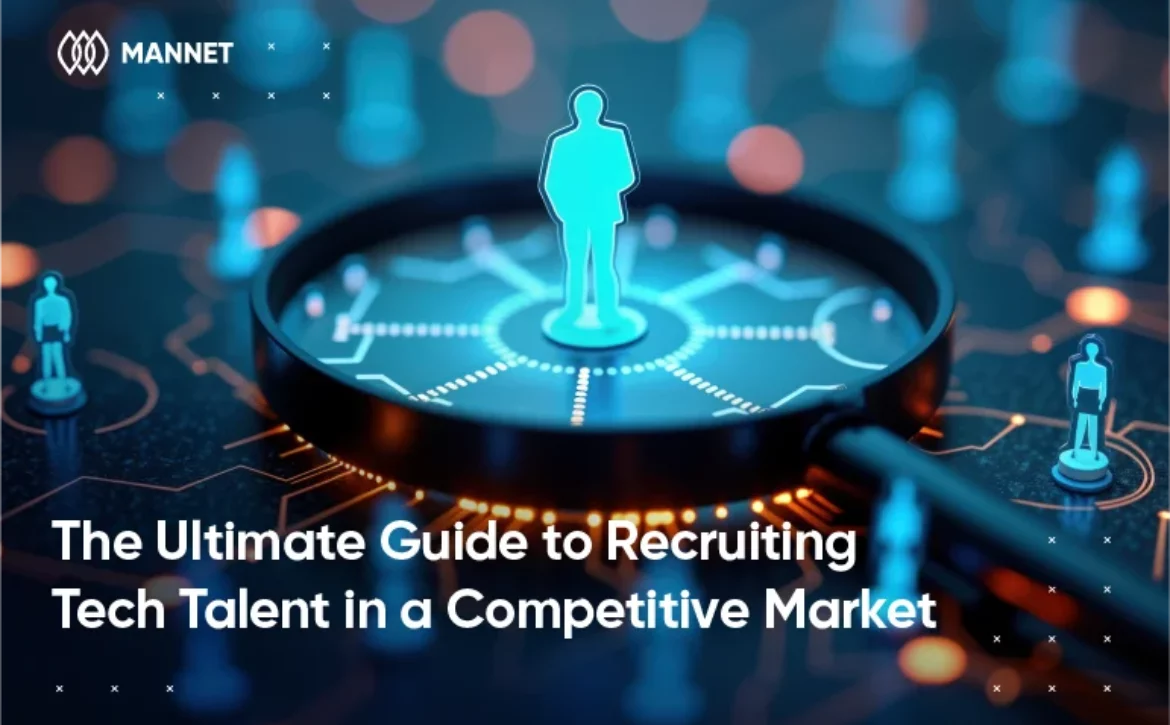With the vast majority of the global workforce active on at least one social platform, social media recruiting has become a logical and highly effective approach.
This shift is supported by compelling data: nearly 75% of job seekers aged 18 to 34 found their most recent job through social media, and approximately 90% of recruiters report making successful hires via LinkedIn alone.
In this blog, we will explore the concept of social media recruiting in depth. Businesses will learn what it involves, why it offers strategic advantages for enterprises, and 8 steps to apply best practices to improve hiring outcomes in a digital-first environment.
What is Social Media Recruiting?
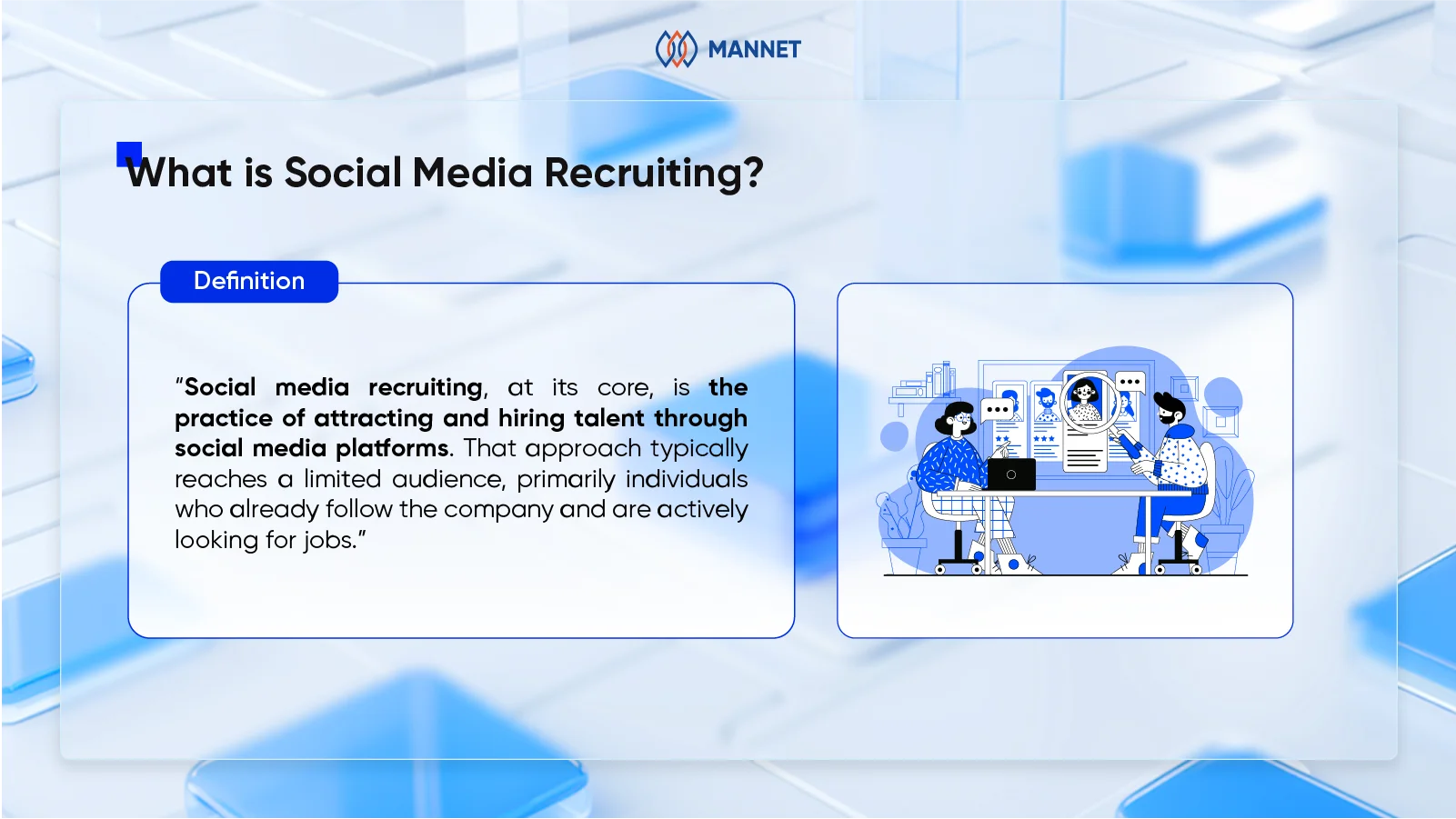
What is social media recruiting?
Social media recruiting, at its core, is the practice of attracting and hiring talent through social media platforms. However, it involves much more than simply posting links to job descriptions. While that approach may generate some applications, it typically reaches a limited audience, primarily individuals who already follow the company and are actively looking for jobs.
Effective social media recruiting includes both passive and active efforts. Passive initiatives may involve maintaining a career page, moderating online communities, and promoting employer branding. On the active side, it includes searching for potential candidates and engaging with them directly. Key advantages of this method include fast, direct communication and the ability to build a broad and relevant network of contacts.
How Is Social Media Used in Recruiting?
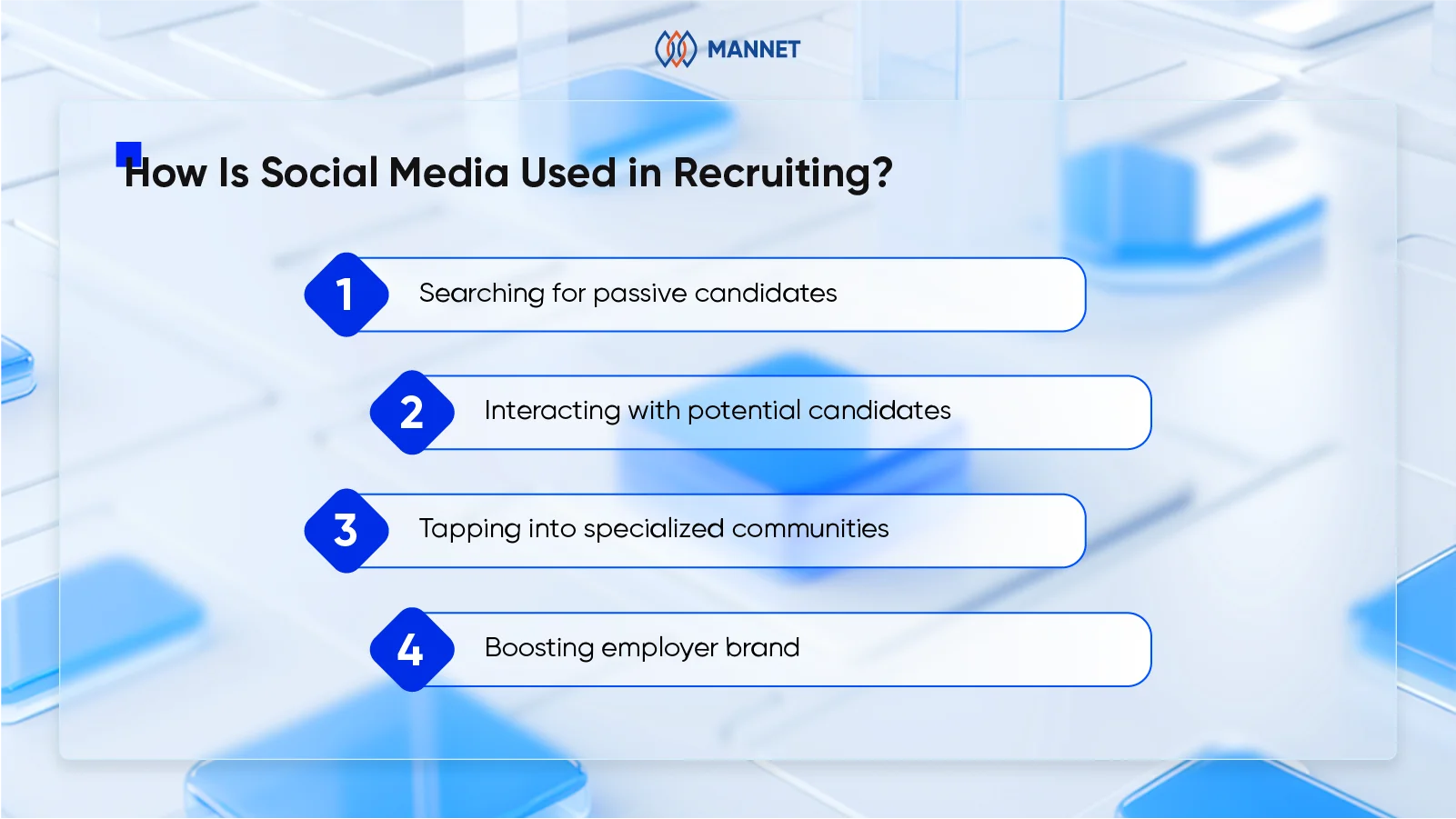
How is social media used in recruiting?
Searching for passive candidates
In fact, 80% of employers say social recruiting helps them reach passive candidates.
Many highly qualified professionals are not actively searching for new roles but remain open to compelling opportunities. Social media offers a direct channel to reach these passive candidates through industry-specific content, job-related posts, and employer branding efforts that gradually build awareness and interest.
Interacting with potential candidates
Beyond job postings, social media allows for two-way communication. Recruiters and hiring teams can interact directly with potential applicants by responding to comments, answering questions, and encouraging meaningful conversations that help move candidates further along the hiring funnel.
Tapping into specialized communities
Different platforms attract different types of talent. For instance, LinkedIn is commonly used for corporate and professional roles, while creative professionals often gravitate toward platforms like Instagram or Behance. By identifying and engaging in these niche networks, recruiters can target specific skill sets with greater precision.
Boosting employer brand
Research shows that 75% of candidates research a company’s reputation before applying, and 62% have used social media to evaluate an employer’s brand.
This makes social media not just a powerful hiring tool but also one of the most effective channels for employer branding. Companies can use their platforms to showcase current employees, highlight workplace culture, communicate values and benefits, and share behind-the-scenes content, offering candidates a transparent view of what it’s like to work there.
Also check out our guide for building a successful employer branding in recruitment.
8 Steps to Successful Social Media Recruiting
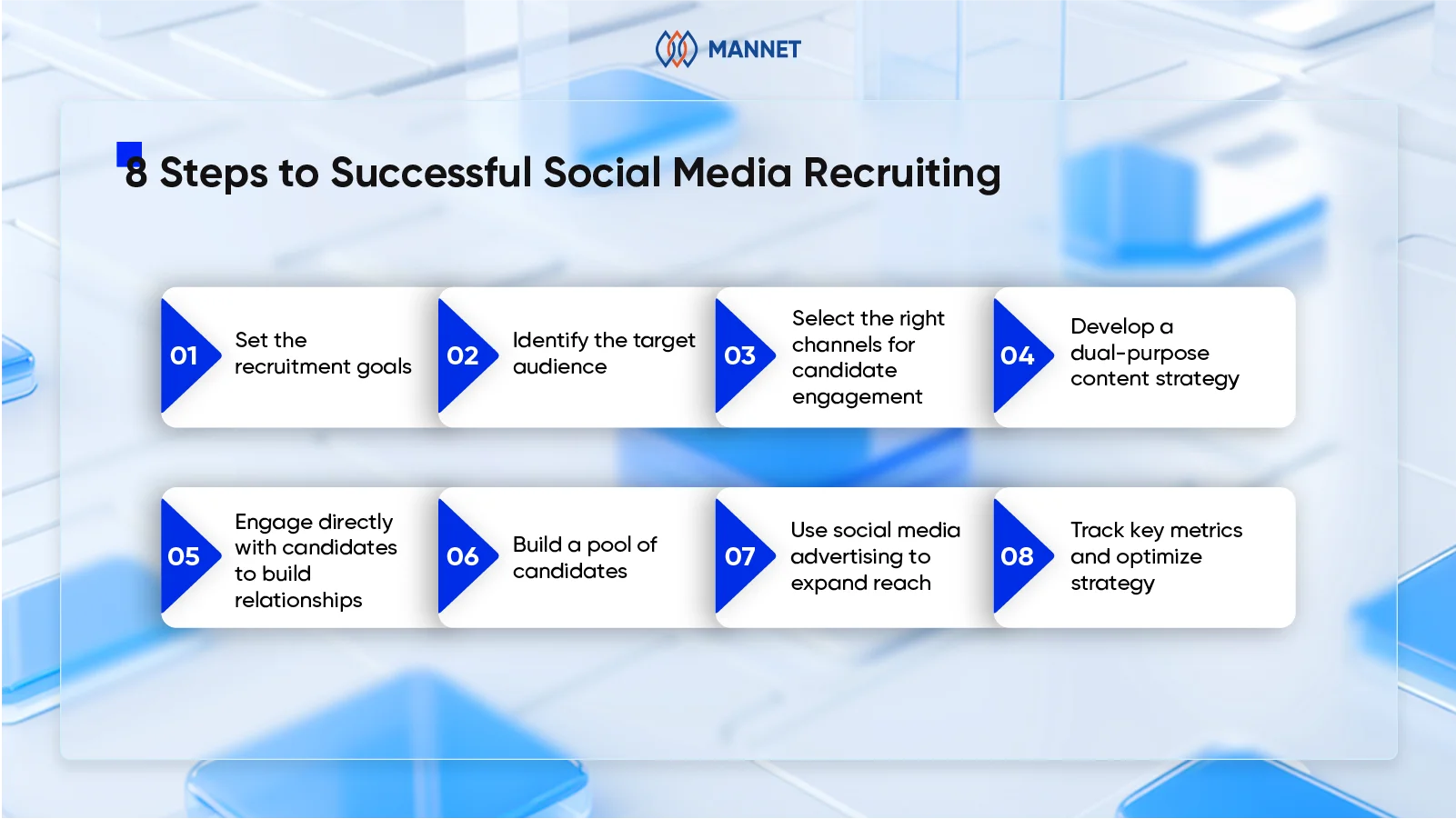
8 steps to successful social media recruiting
Set the recruitment goals
Recruitment via social media should align with a broader talent strategy. Define clear KPIs such as time-to-fill, quality-of-hire, or applicant conversion rate from social channels. For instance, if the goal is to shorten time-to-hire for niche roles, social media campaigns can help increase visibility among hard-to-reach professionals.
Identify the target audience
Create a detailed candidate persona that includes:
- Job title, experience level, and qualifications
- Career aspirations and values
- Online behavior and preferred social platforms
Clearly defining the ideal candidate helps tailor messages to reach the right audience more effectively.
Select the right channels for candidate engagement
Channel selection must be guided by where the target candidates are most active.

- LinkedIn remains dominant for technical, leadership, and B2B roles.
- Instagram and TikTok are gaining traction for roles in creative industries or early-career recruitment.
- Specialized platforms like GitHub, Stack Overflow, or Behance offer targeted access to developers and designers.
Using platform analytics and historical data can refine this decision further.
Develop a dual-purpose content strategy
The content strategy should serve both as a magnet for potential candidates and as a tool to position your company as an employer of choice.
For candidate attraction, include job-related content such as behind-the-scenes videos of your team, day-in-the-life reels, or “why our engineers love working here” interviews.
For brand-building, spotlight leadership, social impact, DEI efforts, and workplace recognitions.
To maximize results, follow the 80/20 content rule: 80% value-driven and culture content and 20% promotional (e.g., job openings). Consistency and authenticity are more effective than over-polished content.
Engage directly with candidates to build relationships
Social media allows hiring teams to humanize their outreach and foster early-stage relationships with prospective candidates.
Companies should respond to comments, answer direct messages, and even host live Q&A sessions to address candidates’ questions. This consistent engagement helps build familiarity and trust, increasing the likelihood that candidates will apply when the right role appears.
Build a pool of candidates
Not everyone who follows companies on social media is ready to apply for a job today. However, those followers may become excellent candidates in the future, and the company should be ready for that.
Businesses can invite followers to join talent communities, subscribe to job alerts, or follow career-specific pages. With the help of CRM or ATS tools, recruiters can track these potential candidates by collecting data on their skills, interests, and engagement level.
Use social media advertising to expand reach
When companies want to reach a larger audience, especially passive candidates, paid social advertising is a highly effective solution.
Platforms such as LinkedIn, Facebook, and Instagram allow precise targeting based on job titles, skills, industries, seniority levels, and more. Businesses can also run retargeting campaigns to re-engage users who previously visited their careers page but didn’t convert.
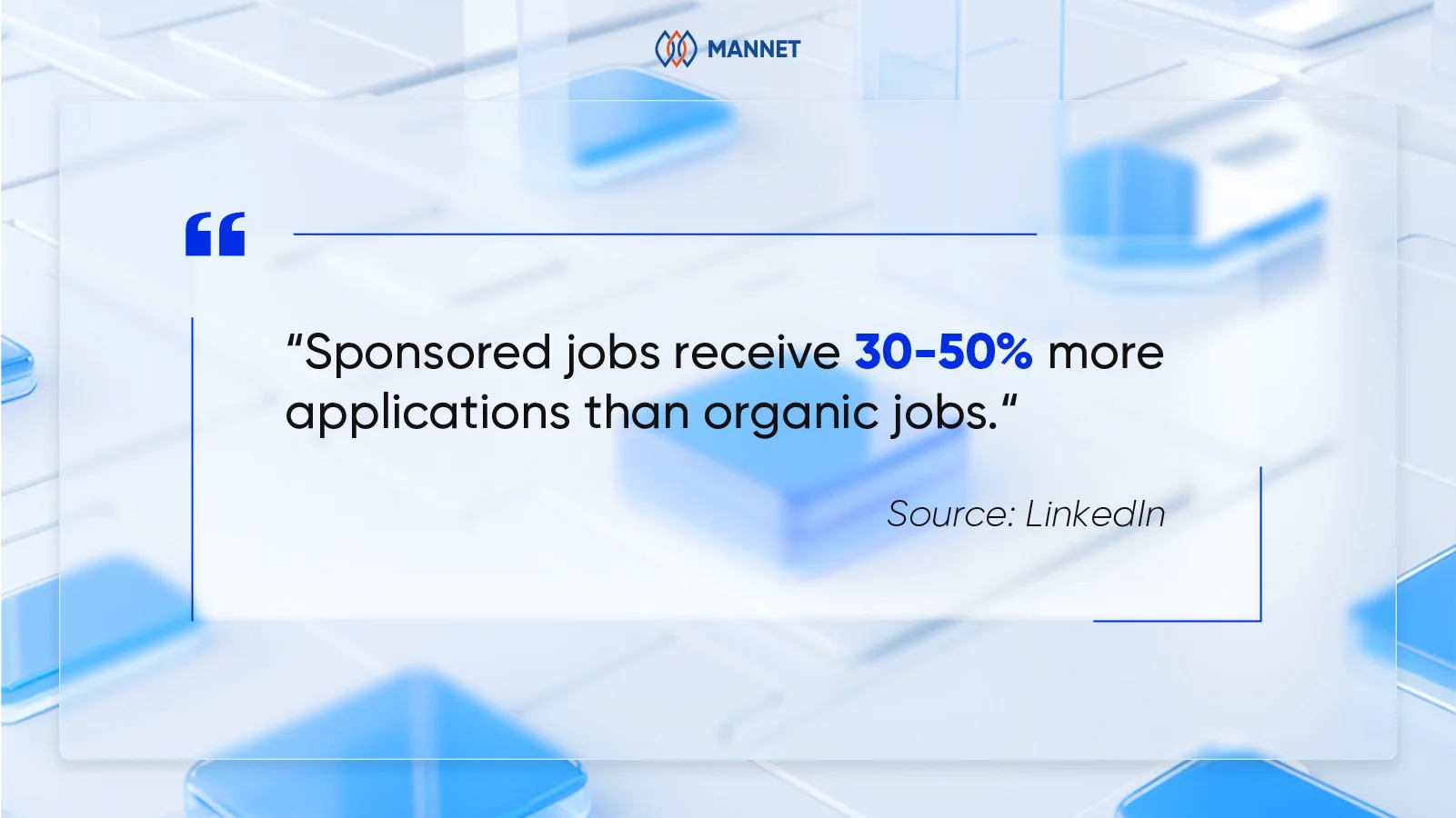
Sponsored jobs vs. applications than organic jobs
Data from LinkedIn shows that sponsored jobs receive 30-50% more applications than organic jobs. For urgent or hard-to-fill positions, this can make a measurable difference in campaign success.
Track key metrics and continuously optimize strategy
A successful social media recruiting strategy is agile, data-driven, and continuously evolving. Rather than focusing on vanity metrics like likes or impressions, recruiters should measure more actionable data:
- Click-through rates (CTR) from job-related posts
- Number of qualified applicants per platform
- Source of hire
- Cost-per-hire
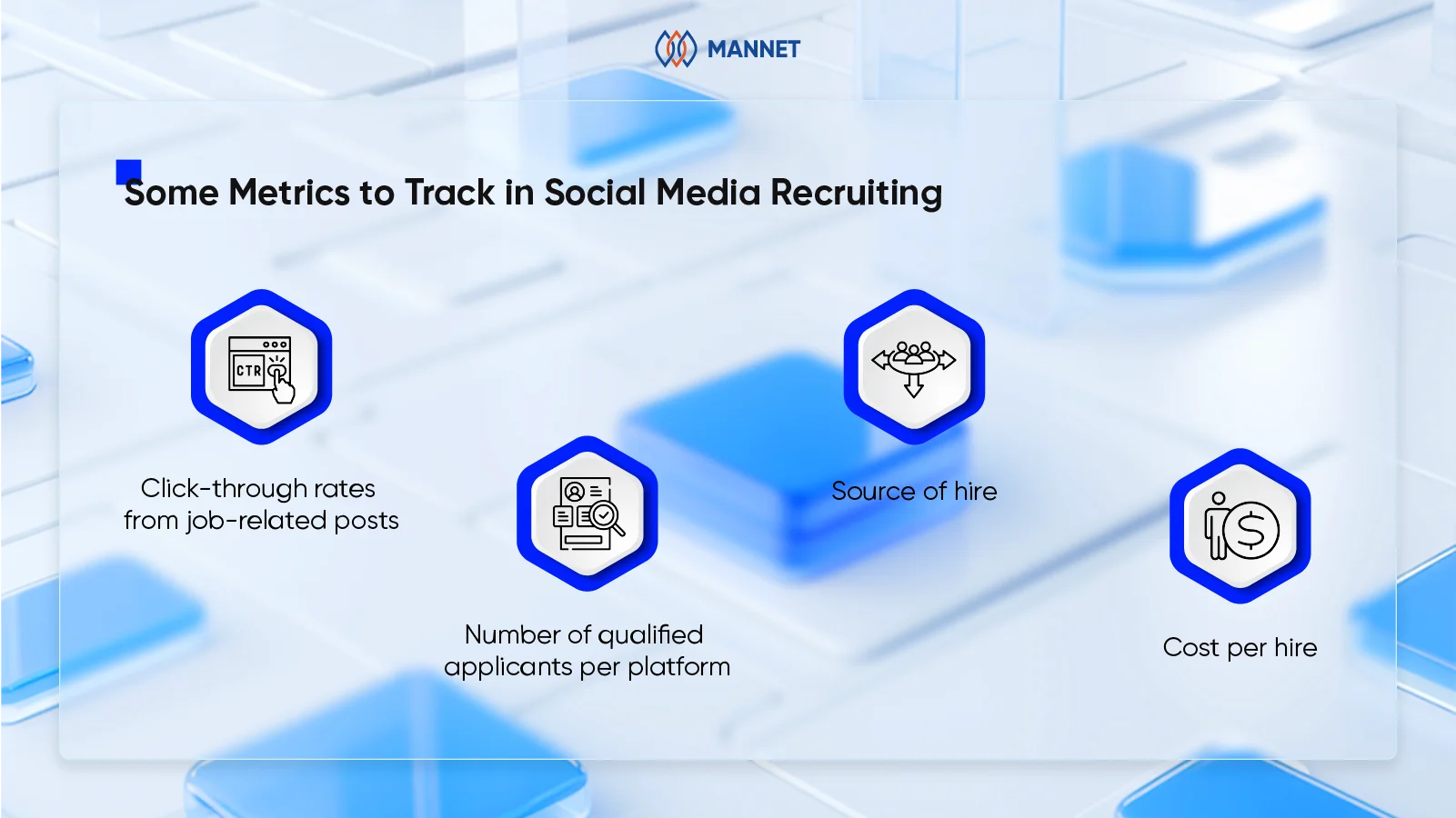
Metrics to track social media recruiting
From these insights, revise the content calendar, targeting parameters, and posting times. With regular performance audits (monthly or per campaign), enterprises may avoid wasted spending and uncover which content or channels yield the highest-quality candidates.
FAQs About Social Media Recruiting
- What is social media recruiting?
Hiring metrics are quantifiable data points that assess the efficiency, effectiveness, and quality of your recruitment process. They help organizations make informed decisions by highlighting areas of success and identifying opportunities for improvement in hiring strategies.
- Which social media platforms are best for recruiting?
- LinkedIn: Best for professional, white-collar, and B2B roles.
- Facebook & Instagram: Useful for employer branding and reaching a younger or more diverse demographic.
- X (Twitter): Effective for sharing updates and engaging with niche communities.
- TikTok: Increasingly used to promote company culture and entry-level opportunities in a creative, informal way.
- GitHub, Behance, and Dribbble: Valuable for targeting technical, design, or creative talent.
- Is social media recruiting only for young candidates?
Not at all. While platforms like Instagram and TikTok skew younger, LinkedIn and Facebook have a wide age distribution. A 2024 Pew Research study showed Americans ages 30 to 49 stand out for using three of the platforms – LinkedIn, WhatsApp, and Facebook – at higher rates, making it highly relevant for mid- to senior-level recruitment.
A Summary of Social Media Recruiting
Social media recruiting has evolved into a strategic necessity for modern talent acquisition. Far beyond simply posting job openings, it enables companies to actively engage with both active and passive candidates, communicate their employer brand, and tap into niche talent pools that may not be reachable through traditional channels.
At ManNet, we provide IT recruiting services to build smarter, more efficient tech hiring strategies, and social media recruiting is a key part of that. For companies seeking a reliable tech recruitment partner, ManNet, backed by years of industry experience, is here to support your hiring success.




